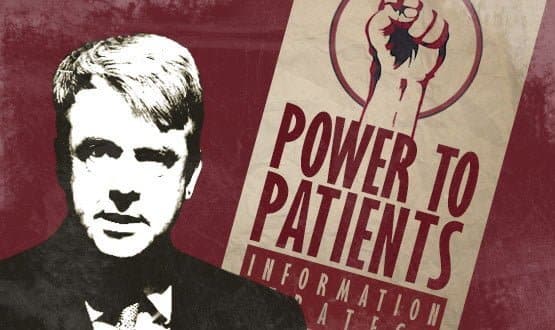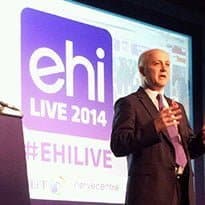Insider view: the NHS information strategy
- 24 May 2012

The eagerly awaited NHS information strategy has finally been published after 18 months of drafting, PowerPoint presentations, and redrafting. The mere fact that it is out is welcome, as is the scale of its ambition.
Admittedly, the ambition doesn’t come through as clearly as it might over 100 pages of a document that has a title so clunky it must have been agreed in a late committee meeting.
Yet, taken as whole, ‘The Power of Information: putting us all in control of the health and care information we need’ is a manifesto for ‘digital first’ health and social care services, joined up by information that is collected once but used many times.
Power to the patient
The strategy’s clearest commitments are made in connection with primary care. Time and again, it says that patients will be able to access records, book appointments, order prescription refills, and have email or video consultations with their doctor or carers.
Yet even here the strategy is curiously uneven. Health secretary Andrew Lansley’s reform white paper, ‘Liberating the NHS’, talked about giving patients access to a wide range of health records, in a form that they could download and share with other organisations.
The NHS had taken some (faltering) steps in this direction, with the creation of the Summary Care Record and its viewer, HealthSpace. Yet a day or so after the strategy was published, Dr Charles Gutteridge, the Department of Health’s national clinical director for informatics, let slip that HealthSpace will be shut down.
Some of its functionality may turn up in a new national portal, alongside bits of NHS Choices and NHS Direct online. But the focus of the Power of Information is GP records.
The evidence for patient demand for this kind of records access is limited, despite the enthusiasm of some well-known pioneers. But there is great evidence for the efficiency and efficacy of transactional services and electronic consultations – particularly from US organisation Kaiser Permenante – which the strategy does not mention.
This is unfortunate, because much of what the strategy describes can already be done using existing GP systems. It’s just that relatively few practices have chosen to use the functionality.
Being able to email a GP remains a rarity in the UK, and the British Medical Association went out of its way to be sniffy about the idea in its response. The strategy fails to say how GPs will be persuaded to change their minds.
But then, as a number of GP commentators have noted, it fails to say what will happen to GP IT support and systems once primary care trusts are abolished and the GPSoC framework runs out next year.
Looking for the person in charge
This unevenness applies to the strategy as a whole. The approach taken by the Power of Information will be welcomed by many after the (mostly) lost years of the National Programme for IT in the NHS.
It is refreshing to read a document that is not laden down with the familiar acronyms of NPfIT, CfH, LSP, CRS and all the rest, and to read one that does not threaten all kinds of centrally-imposed horribleness if targets are missed.
At the same time, it is odd to read a document that makes virtually no mention of NHS information strategies and implementation approaches past. To set out a vision for information, without discussing the technology and systems from which that information and knowledge will be derived, is to deal in the abstract.
Infrastructure and interoperability still require oversight and, in some cases, urgent investment. There is a lot of unfinished business in systems for the acute sector, in particular.
Similarly, to set out a vision for using information across health and social care without saying which organisations will be responsible for doing what is to deal in another abstract.
The much maligned NHS Connecting for Health did manage to achieve a good deal in terms of standards, clinical safety, national services, and training. It is not clear how, or whether, that legacy will be preserved.
And while greater local decision making will be welcomed, few will want the national rudder removed entirely – if only because, with money so tight, commissioners and providers will need help to decide where to invest their limited IT and information budgets most effectively.
The ongoing row over the creation of commissioning support organisations, and whether clinical commissioning groups will be obliged to use them, shows there is a real danger of the NHS both losing valuable expertise in these areas, and of stifling innovation from the private sector.
Having said that, there must be a question mark over one of the unwritten assumptions behind the strategy, which is that the private sector is ready and willing to rush in with new solutions in key areas such as personal health records.
During the last general election campaign, there was much excitement over the idea that big companies like Google and Microsoft might be allowed to take over the provision of PHRs.
Yet Google has since given up on Google Health and Microsoft recently came within a whisker of canning its HealthVault platform; which seems to have been taken up by more innovative trusts than consumers.
Instead of scrapping HealthSpace, a smarter move might have been to copy Microsoft and turn it into a platform that others can connect to and innovate on.
An NHS platform of this kind would offer huge potential to telehealth and telecare providers, as well as those looking for real integration with core NHS information infrastructure and systems.
Show me the money
Finally, the lack of money cannot be ignored. The Power of Information itself is curiously quiet on the subject, but an impact assessment argues that some £5m or so will need to be spent on the national patient portal, NHS standards and access to records – and that this will yield £2.4 billion in benefits.
Yet there is no indication of whether local organisations will get funding for new IT systems or Power of Information Projects.
The minister responsible for the strategy, Earl Howe, told eHealth Insider that capital funds would be available; but the distribution of NHS capital was “too complicated” to get into. He was also unable to clarify whether funds would – or would not – include any money that might – or might not – be left over from NPfIT.
Overall, the Power of Information is out, which is good, and has a discernable vision, which is better. But it is more visionary than strategic.
There are real questions about who will be responsible for delivering it, and when, what systems they will use, who will ensure their interoperability and security, and where the money will come from. Implementation plans are promised. We await them with interest.




